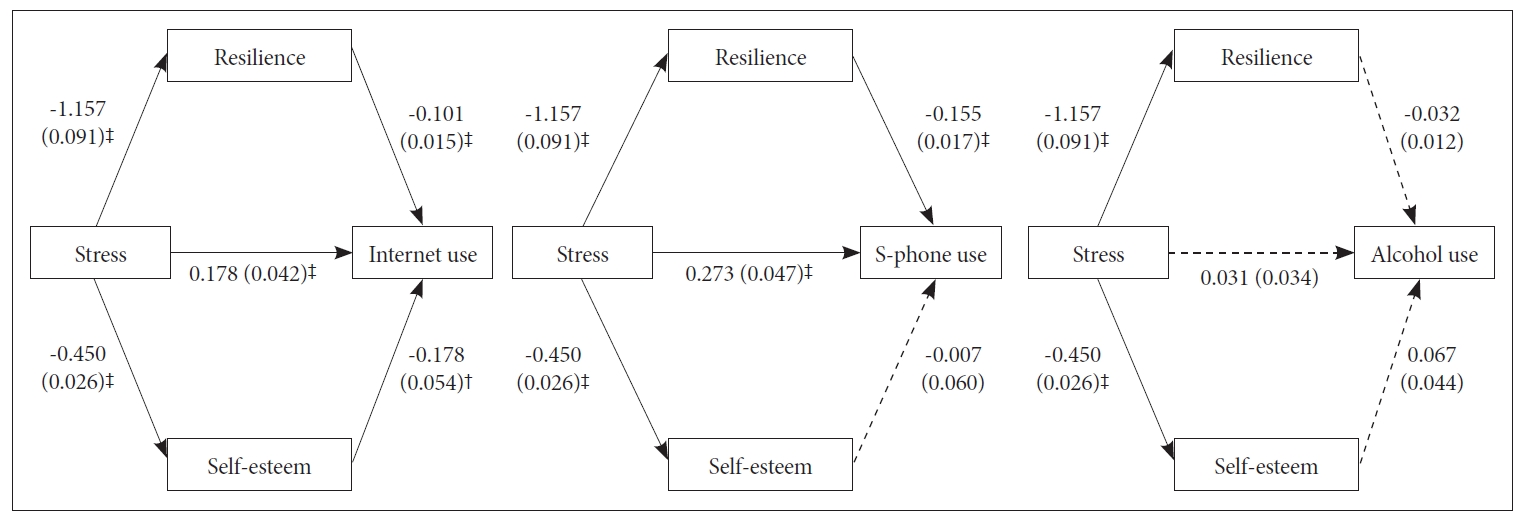1. Pedrelli P, Nyer M, Yeung A, Zulauf C, Wilens T. College students: mental health problems and treatment considerations. Acad Psychiatry 2015;39:503-511.


2. Kromydas T. Rethinking higher education and its relationship with social inequalities: past knowledge, present state and future potential. Palgrave Commun 2017;3:1-12.

3. Chun KH. Relationship between academic burnout of medical and graduate students and related variables. Korean Med Educ Rev 2014;16:77-87.

4. Dyrbye LN, Thomas MR, Shanafelt TD. Systematic review of depression, anxiety, and other indicators of psychological distress among US and Canadian medical students. Acad Med 2006;81:354-373.


8. Newbury-Birch D, Walshaw D, Kamali F. Drink and drugs: from medical students to doctors. Drug Alcohol Depend 2001;64:265-270.


10. Tsimtsiou Z, Haidich AB, Spachos D, Kokkali S, Bamidis P, Dardavesis T, et al. Internet addiction in Greek medical students: an online survey. Acad Psychiatry 2015;39:300-304.


11. Kim HI, Cheon SH, Kang HJ, Lee K, Jung SP. Associations between smartphone addiction scale and sociopsychological aspects in medical school students. Yeungnam Univ J Med 2017;34:55-61.

12. Alsalameh AM, Harisi MJ, Alduayji MA, Almutham AA, Mahmood FM. Evaluating the relationship between smartphone addiction/overuse and musculoskeletal pain among medical students at Qassim University. J Fam Med Prim Care 2019;8:2953-2959.

16. Park H. Prevalence and related risk factors of problem drinking in Korean adult population. J Kor Acad-Ind Coop Soc 2018;19:389-397.
18. Hassanbeigi A, Askari J, Hassanbeigi D, Pourmovahed Z. The relationship between stress and addiction. Proc Soc Behav Sci 2013;84:1333-1340.

20. Kim YK. The influence of stress on alcohol addiction, internet addiction and problem gambling: spiritual well-being as mediator. Korean J Couns 2013;14:97-114.

22. Robertson TW, Yan Z, Rapoza KA. Is resilience a protective factor of internet addiction? Comput Human Behav 2018;78:255-260.

23. Murphy CM, Stosny S, Morrel TM. Change in self-esteem and physical aggression during treatment for partner violent men. J Fam Violence 2005;20:201-210.

24. Bahrainian SA, Alizadeh KH, Raeisoon MR, Gorji OH, Khazaee A. Relationship of internet addiction with self-esteem and depression in university students. J Prev Med Hyg 2014;55:86-89.


25. Uba I, Yaacob SN, Talib MA, Mofrad S, Abdullah R. Effect of self-esteem in the relationship between stress and substance abuse among adolescents: a mediation outcome. Int J Soc Sci Human 2013;3:214-217.

26. National Information Society Agency. Third Standardization of Korean Internet Addiction Proneness Scale. Seoul: National Information Society Agency; 2011.
28. Lee BO, Lee CH, Lee PG, Choi MJ, Namkoong K. Development of Korean version of Alcohol Use Disorders Identification Test (AUDIT-K): its reliability and validity. J Korean Acad Addict Psychiatry 2000;4:83-92.
29. Joe KH, Cha SH, Park A, Lee HK, Shin IH, Min SH. Optimum cut-off score for screening of hazardous drinking using the Korean version of Alcohol Use Disorder Identification Test (AUDIT-K). J Korean Acad Addict Psychiatry 2009;13:34-40.
30. Lee J, Shin C, Ko YH, Lim J, Joe SH, Kim S, et al. The reliability and validity studies of the Korean version of the Perceived Stress Scale. Korean J Psychosom Med 2012;20:127-134.
32. Yoo JS, Yang WS, Lee KE, Lee SE, Lee SK, Lee HY, et al. Gender difference in self-esteem of medical students. Korean J Med Educ 2003;15:241-248.

33. Cohen J. Statistical Power Analysis for the Social Sciences. 2nd Ed. Hillsdale, NJ: Lawrence Erlbaum Associates; 1988.
34. Shankar PR, Balasubramanium R, Ramireddy R, Diamante P, Barton B, Dwivedi N. Stress and coping strategies among premedical and undergraduate basic science medical students in a Caribbean medical school. EIMJ 2014;6:e48-e56.

35. Kardefelt-Winther D. A conceptual and methodological critique of internet addiction research: towards a model of compensatory internet use. Comput Human Behav 2014;31:351-354.

37. Erikson EH. Childhood and Society. New York: WW Norton & Company; 1993.
38. Telzer EH, van Hoorn J, Rogers CR, Do KT. Social influence on positive youth development: a developmental neuroscience perspective. Adv Child Dev Behav 2018;54:215-258.


39. Gunuc S. Peer influence in internet and digital game addicted adolescents: is internet/digital game addiction contagious? Int J High Risk Behav Addict 2016;6:e33681

40. Lim K, Meier EB. Different but similar: computer use patterns between young Korean males and females. Educ Technol Res Dev 2011;59:575-592.

41. Lee HK. Epidemiology of alcohol use disorders and alcohol policy. J Korean Neuropsychiatr Assoc 2019;58:152-158.

42. McMullin SD, Shields GS, Slavich GM, Buchanan TW. Cumulative lifetime stress exposure predicts greater impulsivity and addictive behaviors. J Health Psychol 2021;26:2921-2936.


43. Colder CR. Life stress, physiological and subjective indexes of negative emotionality, and coping reasons for drinking: is there evidence for a self-medication model of alcohol use? Psychol Addict Behav 2001;15:237-245.


44. Alavi SS, Ferdosi M, Jannatifard F, Eslami M, Alaghemandan H, Setare M. Behavioral addiction versus substance addiction: correspondence of psychiatric and psychological views. Int J Prev Med 2012;3:290-294.


47. Brown J, Marshall M. Self-esteem and emotion: some thoughts about feelings. Pers Soc Psychol Bull 2001;27:575-584.

48. Galanakis MJ, Palaiologou A, Patsi G, Velegraki IM, Darviri C. A literature review on the connection between stress and self-esteem. Psychology 2016;7:687-694.

49. Garmezy N, Masten AS, Tellegen A. The study of stress and competence in children: a building block for developmental psychopathology. Child Dev 1984;55:97-111.












